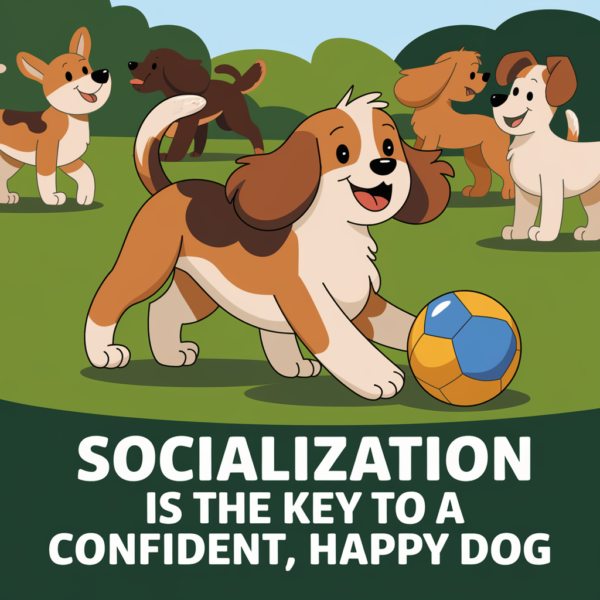Every dog owner knows that a calm and relaxed dog is a happy one, but many of us struggle to understand what our dogs are trying to tell us through their behavior. Whether it’s barking, pacing, or whining, your dog’s actions are a form of communication that, when properly understood, can help you address the root of their stress and create a more peaceful home environment.
Dogs experience anxiety for a variety of reasons—thunderstorms, separation from their owners, or even changes in their routine. Recognizing the signs of stress early can help you take proactive steps to calm your pup. Many dog owners turn to natural solutions like VetriScience Composure Calming Chews, which have been clinically proven to help reduce anxiety in dogs with ingredients like Colostrum, L-Theanine, and Vitamin B1. These calming chews are especially useful during high-stress situations like storms or separation anxiety.
Understanding why your dog may exhibit certain behaviors can give you insight into their emotional state. For instance, if your dog acts overly excited when you get home, it could be a sign of separation anxiety. This behavior is common and often misunderstood as simply excitement, but it may indicate that your dog struggles with being alone. Learn more about this behavior in our article on why your pet acts like a rockstar when you get home.

Common Triggers of Anxiety in Dogs
Just like humans, dogs can experience anxiety triggered by various situations. Understanding these triggers is key to helping your dog remain calm and comfortable. Some of the most common sources of anxiety in dogs include:
- Separation Anxiety: Many dogs become anxious when left alone. This can manifest in behaviors like destructive chewing, excessive barking, or attempts to escape.
- Loud Noises: Thunderstorms, fireworks, or even household appliances can cause your dog to panic. Dogs are particularly sensitive to loud, sudden noises, which can lead to pacing, trembling, or hiding.
- Changes in Routine or Environment: Dogs thrive on routine, and even small changes—such as moving to a new home or a shift in daily activities—can lead to stress.
- Social Anxiety: Some dogs are uncomfortable around other dogs or unfamiliar people. This type of anxiety can cause growling, hiding, or other avoidance behaviors.
Recognizing your dog’s specific triggers allows you to prepare in advance. Natural supplements, like VetriScience Composure Calming Chews, can be helpful in reducing their stress response in these situations. For long-term anxiety management, exploring holistic options like CBD for Dogs is also an option. CBD can have calming effects when used appropriately, helping to keep your dog relaxed during stressful events.
Those that are thinking about adopting a rescue dog or just did recently, you should read our article on the first 7 days after adopting a rescue dog!

How to Recognize Anxiety in Your Dog
Recognizing the signs of anxiety in your dog is the first step in helping them feel more relaxed. Dogs may not be able to communicate their feelings verbally, but their behavior and body language speak volumes. Common signs of anxiety in dogs include:
- Pacing or Restlessness: If your dog can’t seem to settle down, constantly walking around the house or yard, it’s often a sign of nervousness.
- Excessive Barking or Whining: Vocalization is one of the most noticeable signs of anxiety. Dogs may bark or whine when they’re feeling stressed or insecure.
- Shaking or Trembling: If your dog begins shaking or trembling during a storm or in new environments, it’s likely due to anxiety.
- Destructive Behavior: Chewing furniture, scratching at doors, or tearing up pillows can be signs of separation anxiety or boredom.
- Loss of Appetite: Anxiety can suppress your dog’s desire to eat, which can lead to sudden changes in their eating habits.
Once you notice these behaviors, it’s essential to provide your dog with comfort. Creating a calming environment, whether by giving them access to a cozy spot like a Bouclé Dog Bed for ultimate comfort, or simply being present, can make a big difference. Pairing this with calming treats, such as VetriScience Composure Calming Chews, can help reduce your dog’s stress levels and bring them some much-needed peace.

Tips for Calming an Anxious Dog
When your dog is showing signs of anxiety, there are several methods you can use to help them feel more relaxed. Whether it’s through creating a calming environment or offering a soothing distraction, here are a few tips to help calm your anxious dog:
- Create a Safe Space: Set up a quiet, comfortable area where your dog can retreat during stressful situations. This could be a corner of your home with their bed or crate, or even a cozy spot with their favorite blanket. A calming space, like a Bouclé Dog Bed, provides comfort and security for your pet during moments of stress.
- Use Calming Supplements: Products like VetriScience Composure Calming Chews can be extremely effective for dogs experiencing anxiety. These chews are made with natural ingredients like L-Theanine and Vitamin B1, which help reduce stress levels without causing drowsiness.
- Provide Distractions: Keeping your dog engaged with interactive toys, puzzles, or games can help redirect their focus away from stress triggers. If bad weather or loud noises are causing anxiety, try distracting your dog with a game or even teaching them new tricks.
- Exercise and Mental Stimulation: A well-exercised dog is generally a calmer dog. Regular walks, playtime, and mental challenges like puzzle toys can help tire your dog out, reducing the likelihood of anxious behavior. For indoor days, try these Engaging Indoor Activities to keep your dog active and entertained.
By using these tips, you can help your dog feel more at ease and better equipped to handle stressful situations.

Deciphering Dog Behavior
- Communication: Dogs communicate with us in various ways, from barking and growling to tail wagging and whining. Recognizing what each signal means can improve your relationship with your pet.
- Natural Instincts: Many dog behaviors, like digging or chasing, are rooted in their natural instincts. Understanding this can help you channel these behaviors in a positive way.
- Training Challenges: Sometimes, undesirable behaviors arise from a lack of proper training or misunderstandings. Addressing these can lead to a more obedient and happy dog.
Unlocking the Secrets of Dog Behavior
If you’ve ever wished for a manual to understand your dog better, your wish has just come true. Brain Training for Dogs is not just about tricks and games; it delves deep into canine psychology. This program offers insights into why dogs act the way they do and provides actionable strategies to address behavioral challenges.
Whether you’re dealing with a new puppy’s antics or an older dog’s sudden change in behavior, Brain Training for Dogs offers solutions tailored to every canine conundrum.

Deepen Your Bond Through Understanding
The more you understand your dog, the deeper your bond will be. With Brain Training for Dogs, you’ll gain insights into the canine mind, allowing you to address issues, train more effectively, and ultimately lead a more harmonious life with your pet.
Our dogs are more than just pets; they’re family. By investing time in understanding their behaviors and needs, we can ensure a happier, more fulfilling life for them. If you’re ready to dive deep into the world of canine behavior and training, click here to discover the comprehensive guide that is Brain Training for Dogs. Your journey to a calmer, more understanding relationship with your dog begins here.
As an Amazon Associate we earn from qualifying purchases through some links in our articles.




